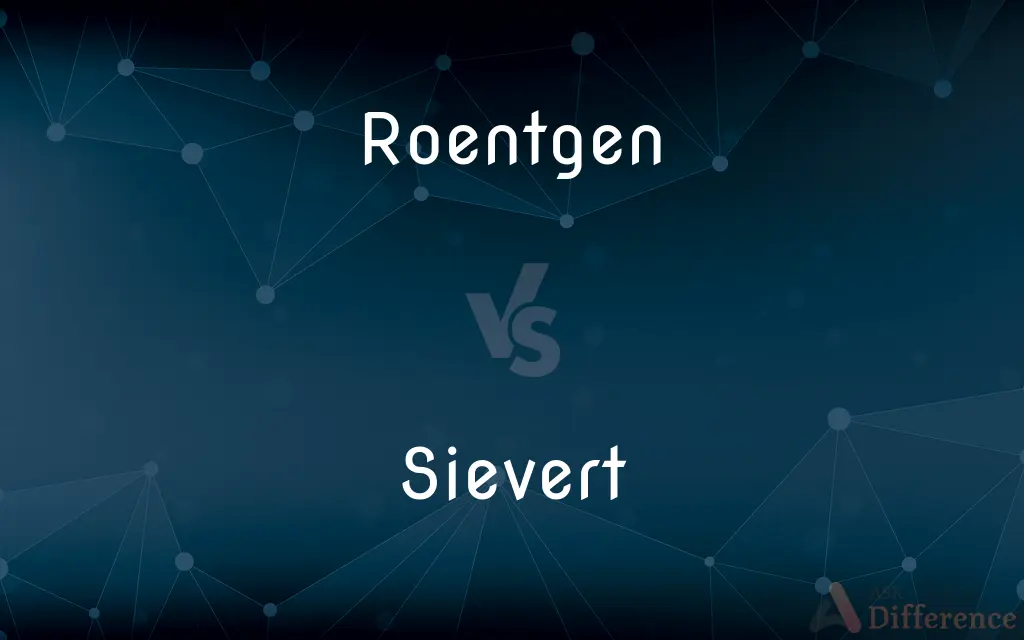Roentgen vs. Sievert — What's the Difference?
Edited by Tayyaba Rehman — By Fiza Rafique — Updated on October 5, 2023
Roentgen measures the amount of ionizing radiation in the air, while Sievert quantifies the biological impact of ionizing radiation on tissue.

Difference Between Roentgen and Sievert
Table of Contents
ADVERTISEMENT
Key Differences
Roentgen (R) is a unit that measures the exposure or ionization produced in air by X-rays or gamma radiation. Sievert (Sv), however, gauges the biological impact of ionizing radiation, considering the type and sensitivity of tissue exposed.
Roentgen specifically measures the amount of ionization in air, while the unit Sievert is more complex, quantifying the effective dose or potential harm of ionizing radiation on biological tissue, including factors like radiation type and tissue sensitivity.
Roentgen, being a legacy unit, is less commonly used in modern radiology, with other units like the Coulomb per kilogram replacing it in many applications. Sievert, however, remains a vital unit in radiation protection, depicting potential biological risks.
While Roentgen is exclusively for ionization produced in the air by X-rays or gamma radiation, Sievert encompasses a broader range, assessing the biological effect of all types of ionizing radiation, including alpha and beta particles.
The term Roentgen pays homage to Wilhelm Conrad Roentgen, the discoverer of X-rays. Sievert is named after Rolf Maximilian Sievert, who made significant contributions to the study of radiation dosage and its effects on health.
ADVERTISEMENT
Comparison Chart
Measurement Focus
Ionizing radiation in air.
Biological impact of ionizing radiation on tissue.
Units
Legacy unit, less common in modern radiology.
Widely used in radiation protection and biology.
Application
Primarily for X-rays and gamma radiation.
All types of ionizing radiation.
Context
Measures exposure in air.
Considers type and sensitivity of tissue exposed.
Historical Reference
Named after Wilhelm Conrad Roentgen.
Named after Rolf Maximilian Sievert.
Compare with Definitions
Roentgen
Honoring the discoverer of X-rays, Wilhelm Conrad Roentgen.
The term Roentgen pays tribute to the pioneer of X-ray discovery.
Sievert
A unit that quantifies the biological impact of ionizing radiation.
The workers were exposed to 2 milliSieverts of radiation.
Roentgen
Legacy unit for radiation exposure.
In the early 20th century, doses were often recorded in Roentgens.
Sievert
Measuring effective dose considering radiation type and tissue sensitivity.
Sievert calculations are essential for assessing potential health risks.
Roentgen
A non-SI unit, not commonly used today.
While Roentgen was popular in the past, today's measurements often use different units.
Sievert
Encompassing the potential harm of all ionizing radiation types.
Sievert provides a comprehensive evaluation, unlike some other units.
Roentgen
A unit measuring ionization produced in air by X-rays or gamma radiation.
The radiation emitted was calculated to be 5 Roentgens.
Sievert
Named in honor of Rolf Maximilian Sievert.
The Sievert unit acknowledges Rolf Sievert's contributions to radiology.
Roentgen
Pertaining to the amount of ionizing radiation in the air.
The Roentgen reading indicated a significant radiation spike.
Sievert
A standard unit in radiation protection and radiobiology.
All radiation workers should be familiar with the Sievert measurement.
Roentgen
A unit of radiation exposure equal to the quantity of ionizing radiation that will produce one electrostatic unit of electricity in one cubic centimeter of dry air at 0°C and standard atmospheric pressure.
Sievert
The sievert (symbol: Sv) is a derived unit of ionizing radiation dose in the International System of Units (SI) and is a measure of the health effect of low levels of ionizing radiation on the human body. The sievert is important in dosimetry and radiation protection, and is named after Rolf Maximilian Sievert, a Swedish medical physicist renowned for work on radiation dose measurement and research into the biological effects of radiation.
Roentgen
A unit of radiation exposure; the dose of ionizing radiation that will produce 1 electrostatic unit of electricity in 1 cc of dry air
Sievert
The SI unit for the amount of ionizing radiation required to produce the same biological effect as one rad of high-penetration x-rays, equivalent to a gray for x-rays.
Roentgen
German physicist who discovered x-rays and developed roentgenography (1845-1923)
Sievert
In the International System of Units, the derived unit of radiation dose; the dose received in one hour at a distance of 1 cm from a point source of 1 mg of radium in a 0.5 mm thick platinum enclosure. Symbol: Sv
Common Curiosities
Is Roentgen still commonly used in radiology?
No, Roentgen is a legacy unit and has been replaced by other units in many applications.
What does Roentgen specifically measure?
Roentgen measures the ionizing radiation in air, particularly from X-rays or gamma radiation.
Which unit is more comprehensive, Roentgen or Sievert?
Sievert is more comprehensive, considering various radiation types and tissue sensitivities.
How is Sievert different from Roentgen?
While Roentgen measures radiation in air, Sievert quantifies the biological impact of radiation on tissue.
Why is Sievert important in health sectors?
Sievert gauges the potential biological risks of ionizing radiation, crucial for radiation protection.
Why is Sievert essential for radiation workers?
Sievert evaluates potential health risks from radiation exposure, ensuring worker safety.
How do radiologists determine potential biological harm?
They often use the Sievert unit, which evaluates the biological impact of radiation.
Can both units be used interchangeably?
No, they measure different aspects of radiation and aren't interchangeable.
Which unit, Roentgen or Sievert, has a broader application?
Sievert has a broader application, assessing the effects of all ionizing radiation types.
Which unit is named after a significant figure in radiobiology?
Sievert is named after Rolf Maximilian Sievert, a key figure in radiobiology.
Does Roentgen account for radiation type?
No, Roentgen specifically measures ionization produced by X-rays or gamma radiation in the air.
Who is the term "Roentgen" named after?
It's named after Wilhelm Conrad Roentgen, the discoverer of X-rays.
Is Roentgen an SI unit?
No, Roentgen is a non-SI unit.
Can Roentgen measure radiation from alpha or beta particles?
No, Roentgen is specific to ionizing radiation in the air from X-rays or gamma radiation.
Why is it important to consider tissue sensitivity in radiation measurements?
Different tissues have varied sensitivities to radiation; the Sievert unit accounts for this in assessing potential harm.
Share Your Discovery

Previous Comparison
Bondsman vs. Slave
Next Comparison
Cannelloni vs. CannoliAuthor Spotlight
Written by
Fiza RafiqueFiza Rafique is a skilled content writer at AskDifference.com, where she meticulously refines and enhances written pieces. Drawing from her vast editorial expertise, Fiza ensures clarity, accuracy, and precision in every article. Passionate about language, she continually seeks to elevate the quality of content for readers worldwide.
Edited by
Tayyaba RehmanTayyaba Rehman is a distinguished writer, currently serving as a primary contributor to askdifference.com. As a researcher in semantics and etymology, Tayyaba's passion for the complexity of languages and their distinctions has found a perfect home on the platform. Tayyaba delves into the intricacies of language, distinguishing between commonly confused words and phrases, thereby providing clarity for readers worldwide.
















































